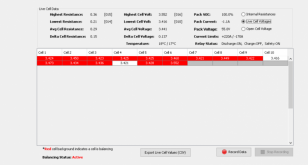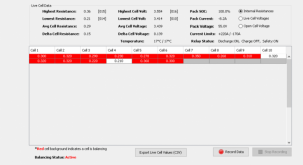Thanks. Do these IR readings from my Orion look problematic? It's snowing here so I am going to fire up the genset and I'll post again when cell 16 is over 3.6vIf you have major variance in the IR readings on the Orion BMS, that indicates connection issues. Debris, loose connections, unflat bus bars, burrs, etc. A torque wrench and studs/nuts are the best approach for consistent connections.
Only use very fine (600 grit) sandpaper on the terminals. You are wanting to polish, not scratch.
You are using an out of date browser. It may not display this or other websites correctly.
You should upgrade or use an alternative browser.
You should upgrade or use an alternative browser.
Best way to burn some juice of a couple runners?
- Thread starter hammick
- Start date
Luthj what do you mean by 20% or 50%. My BMS shows IR in mOhmsIf you have major variance in the IR readings on the Orion BMS, that indicates connection issues. Debris, loose connections, unflat bus bars, burrs, etc. A torque wrench and studs/nuts are the best approach for consistent connections. 20% is fine for lower C rates, and 50% or greater will cause voltage spikes during charging.
Only use very fine (600+ grit) sandpaper on the terminals. You are wanting to polish, not scratch.
curiouscarbon
Science Penguin
- Joined
- Jun 29, 2020
- Messages
- 3,022
they might have meant % variance between mOhm valuesLuthj what do you mean by 20% or 50%. My BMS shows IR in mOhms
Your 0.1-0.13 mOhm range is probably acceptable for your application. The cells at 0.17-0.19 may have poor connections.
By percentages I was talking about the total difference between the highest and lowest cell. IR varies with temp and SOC, so you are mostly concerned with how even the cells are.
Note that these values are sensitive to SOC at the top/bottom. So badly out of balance cells can have very different IR readings at that level. As long as you are between 3.0-3.3V, this shouldn't be a major factor.
Once you get the cells balance within 10mv, apply a load to the pack. I would guess the higher IR cells will experience a higher voltage drop than the others, which confirms a resistance variance on those cells.
By percentages I was talking about the total difference between the highest and lowest cell. IR varies with temp and SOC, so you are mostly concerned with how even the cells are.
Note that these values are sensitive to SOC at the top/bottom. So badly out of balance cells can have very different IR readings at that level. As long as you are between 3.0-3.3V, this shouldn't be a major factor.
Once you get the cells balance within 10mv, apply a load to the pack. I would guess the higher IR cells will experience a higher voltage drop than the others, which confirms a resistance variance on those cells.
Last edited:
Ampster
Renewable Energy Hobbyist
I am on my phone fo a few hours so can't compare easily. Cell 13 shows 0.00 but maybe aberation. I would also look at the two mentioned above. Maybe after cells get balanced. 54.5 CV setting may avoid cells running.
curiouscarbon
Science Penguin
- Joined
- Jun 29, 2020
- Messages
- 3,022
Cell 13
0.080
??(?)
0.080
??(?)
Hey Ampster can I rely on the internal resistance readings from the Orion BMS utility or do I need to disconnect and put a meter on my two offending cells. I sanded all terminals, buss bars and washers and then cleaned with alcohol.
What is the range (min/max) of your IR's?
Edit: N/M you answered above
Thanks for all the help! I looked at my fancy (and expensive) braided buss bars and it appears that when they punch the holes it deforms the surface on some of them. I removed the bars that connect to cells 16 and 1 (my runner cells) and hammered them flat and gave a good polishing with 1500 grit sandpaper. That seems to have fixed those two cells from running. I'm going to get some 600 grit sanding blocks so I can do a better job. I will also hammer the other buss bars that are on cells with higher resistance.




Tomorrow and Wed look to be full sun. I'm going to set the CC to 54.5 and let the BMS do it's job. Thanks.Change the max voltage of your charger until your cells are balanced. Despite the low balance current, my Orion corrects my cells within a day or two.
Did you try the 100w bulb? If so, what gauge wire did you use? My 16th cell is still running way high and I need to figure a way to burn some watts off tomorrow. Thanks.Has anyone tried using an old style incandescent 100w light bulb to draw down the voltage?
It could avoid the issues with excessive heat you get with a resistor.
I wouldn't expect any light, but it should draw some power.
I'll try it out myself later today ...
Did you try the 100w bulb? If so, what gauge wire did you use? My 16th cell is still running way high and I need to figure a way to burn some watts off tomorrow. Thanks.
Measure the resistance and use something like https://ohmslawcalculator.com/ohms-law-calculator to figure out the draw and then use appropriately-sized cable. Resistance will increase as the filament gets hot, but this is a bulb designed to draw ~1 amp at 120 volts while hot and you're using 3.2 volts so it's not going to be much.
So if I use 6ga wire can I leave it connected and watch the voltages on my Orion BMS and when the voltage of the 16th cell drops say to the middle of the average cell voltage call it good, start charging and see the results? Any reason I need to isolate the cell? If I do that I can't monitor on the Orion utility.Measure the resistance and use something like https://ohmslawcalculator.com/ohms-law-calculator to figure out the draw and then use appropriately-sized cable. Resistance will increase as the filament gets hot, but this is a bulb designed to draw ~1 amp at 120 volts while hot and you're using 3.2 volts so it's not going to be much.
Thanks!
Ampster
Renewable Energy Hobbyist
No need to isolate the cell. The best place to reduce the voltage is near the top if you can because up there the voltage will be closer to SOC.
BarkingSpider
Carbon Lifeform
Hi, I tried the 100 incandesant light bulb, it works, but very slowly, if you want to lower your cell voltage 100x faster, use this, It lowers the voltage very quickly, and is much safer.Did you try the 100w bulb? If so, what gauge wire did you use? My 16th cell is still running way high and I need to figure a way to burn some watts off tomorrow. Thanks.
Simply short the two poles of your battery through this resistor, You may need to add some thick wire to make it reach, 10 gauge would be fine. You could also use car jumper leads.
As a safety test, I hold on to it, when it gets too hot to hold any longer, I disconect it from the battery. Its a $10 200W heavy duty resistor.
KKmoon RX24 200W 1ohm / 2ohm / 4ohm / 8ohm / 10ohm Aluminum Shell Resistance Metal Wirewound Wire Wound Winding Resistor Dummy Road - - Amazon.com
KKmoon RX24 200W 1ohm / 2ohm / 4ohm / 8ohm / 10ohm Aluminum Shell Resistance Metal Wirewound Wire Wound Winding Resistor Dummy Road - - Amazon.com
www.amazon.com
I use these resistors all the time to avoid sparks, anytime you connect your inverter, BMS or similar to your battery, Use this inline on the end of the wire first. Just a 1 second touch is all you need, then connect the leads as normal. The polarity is not important. No more sparks!
Last edited:
Thanks. I only have a few days to get this done so I'll have to get the resistor for the next trip up here. Can you tell me what you mean by slow for the light bulb? Hours or days?Hi, I tried the 100 incandesant light bulb, it works, but very slowly, if you want to lower your cell voltage 100x faster, use this, It lowers the voltage very quickly, and is much safer.
Simply short the two poles of your battery through this resistor, You may need to add some thick wire to make it reach, 10 gauge would be fine. You could also use car jumper leads.
As a safety test, I hold on to it, when it gets too hot to hold any longer, I disconect it from the battery. Its a $10 200W heavy duty resistor.
KKmoon RX24 200W 1ohm / 2ohm / 4ohm / 8ohm / 10ohm Aluminum Shell Resistance Metal Wirewound Wire Wound Winding Resistor Dummy Road - - Amazon.com
KKmoon RX24 200W 1ohm / 2ohm / 4ohm / 8ohm / 10ohm Aluminum Shell Resistance Metal Wirewound Wire Wound Winding Resistor Dummy Road - - Amazon.comwww.amazon.com
I use these resistors all the time to avoid sparks, anytime you connect your inverter, BMS or similar to your battery, Use this inline on the end of the wire first. Just a 1 second touch is all you need, then connect the leads as normal. The polarity is not important. No more sparks!
Ampster
Renewable Energy Hobbyist
It depends on resistance. At 3.2 volts one Ohm will pull 3.2 Amps and get hot.Can you tell me what you mean by slow for the light bulb? Hours or days?
I= V/R
At that rate it might only take 30 minutes.
Last edited:
BarkingSpider
Carbon Lifeform
OK, I tried fruit, vegetables and other stuff for home made resistors, then realised I already have big resistors all over my house And they work great.Thanks. I only have a few days to get this done so I'll have to get the resistor for the next trip up here. Can you tell me what you mean by slow for the light bulb? Hours or days?
Simply connect your batteries to the AC leads on your
1) Soldering iron (200 ohms)
2) Hot glue gun (80 ohms)
3) Iron
4) Electric heater
etc etc, the voltage dropped fastest with my hot glue gun. I used 2 x 1ft 14 gauge wires with crocodile clips on to connect the battery. So any old wires around the house will work fine.
The higher the voltage you use, the faster it works, so put your high voltage cells in series to bulk reduce the power at first, then do one at a time when they are close to the voltage you want.
Last edited:
Interesting. I only have one cell that I need to drain. What size wire do you recommend if I use our iron?OK, I tried fruit, vegetables and other stuff for home made resistors, then realised I already have big resistors all over my house And they work great.
Simply connect your batteries to the AC leads on your
1) Soldering iron (200 ohms)
2) Hot glue gun (80 ohms)
3) Iron
4) Electric heater
etc etc, the voltage dropped fastest with my hot glue gun. I used 2 x 1ft 14 gauge wires with crocodile clips on to connect the battery. So any old wires around the house will work fine.
The higher the voltage you use, the faster it works, so put your high voltage cells in series to bulk reduce the power at first, then do one at a time when they are close to the voltage you want.
Similar threads
- Replies
- 4
- Views
- 565
- Replies
- 22
- Views
- 998
- Replies
- 258
- Views
- 12K



